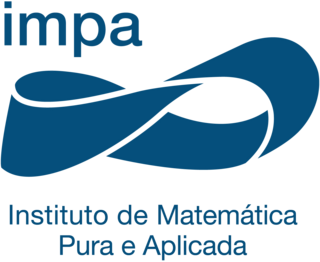
The Instituto Nacional de Matemática Pura e Aplicada is considered to be the foremost research and educational institution of Brazil in the area of mathematics. It is located in the city of Rio de Janeiro, and was formerly known simply as Instituto de Matemática Pura e Aplicada (IMPA), whose abbreviation remains in use.
Titu Andreescu is an associate professor of mathematics at the University of Texas at Dallas. He is firmly involved in mathematics contests and olympiads, having been the Director of American Mathematics Competitions, Director of the Mathematical Olympiad Program, Head Coach of the United States International Mathematical Olympiad Team, and Chairman of the United States of America Mathematical Olympiad. He has also authored a large number of books on the topic of problem solving and olympiad-style mathematics.
This article describes the selection process, by country, for entrance into the International Mathematical Olympiad.

Maurício Matos Peixoto,, was a Brazilian engineer and mathematician. He pioneered the studies on structural stability, and was the author of Peixoto's theorem.

Elon Lages Lima was a Brazilian mathematician whose research concerned differential topology, algebraic topology, and differential geometry. Lima was an influential figure in the development of mathematics in Brazil.

Artur Avila Cordeiro de Melo is a Brazilian mathematician working primarily in the fields of dynamical systems and spectral theory. He is one of the winners of the 2014 Fields Medal, being the first Latin American and lusophone to win such award. He has been a researcher at both the IMPA and the CNRS. He has been a professor at the University of Zurich since September 2018.
The Brazilian Physical Society is a non-profit organization of physicists and physics teachers, affiliated with the Brazilian Society for the Progress of Science . Its main missions are to promote the advancement and dissemination of knowledge in physics and science; to defend academic freedom, as well as the interests and rights of professionals in physics, and to contribute to initiatives and public policies aiming to improve the training and harnessing of physics teachers and physicists to help the scientific and technological development of Brazil.

Welington Celso de Melo was a Brazilian mathematician. Known for his contributions to dynamical systems theory, he served as full professor at Instituto Nacional de Matemática Pura e Aplicada from 1980 to 2016. Melo wrote numerous papers, one being a complete description of the topological behavior of 1-dimensional real dynamical systems . He proved the global hyperbolicity of renormalization for Cr unimodal maps. He was a recipient of the 2003 TWAS Prize.
The Brazilian Mathematical Society is a professional association founded in 1969 at Instituto de Matemática Pura e Aplicada to promote mathematics education in Brazil.

The Brazilian Mathematical Olympiad of Public Schools (OBMEP) is an annual Mathematics contest created in 2005 by the Brazilian Ministério da Ciência e Tecnologia (MCT) and Ministério da Educação (MEC), in collaboration with Instituto Nacional de Matemática Pura e Aplicada (IMPA) and Sociedade Brasileira de Matemática (SBM), to stimulate the mathematics education in Brazil. It is open to public school students from fifth grade to high school. In 2014 more than 18 million students were enrolled for its first round.

Fernando Codá dos Santos Cavalcanti Marques is a Brazilian mathematician working mainly in geometry, topology, partial differential equations and Morse theory. He is a professor at Princeton University. In 2012, together with André Neves, he proved the Willmore conjecture. Since then, among proving other important conjectures, Marques and Neves greatly extended Almgren–Pitts min-max theory to prove theorems about minimal surfaces.

Marcelo Miranda Viana da Silva is a Brazilian mathematician working in dynamical systems theory. He proved the Zorich–Kontsevich conjecture together with Artur Avila.
Carlos Gustavo Tamm de Araújo Moreira is a Brazilian mathematician working on dynamical systems, ergodic theory, number theory and combinatorics. Moreira is currently a researcher at the Instituto Nacional de Matemática Pura e Aplicada (IMPA), where he goes by the nickname "Gugu". He is also a member of the Brazilian Mathematical Olympiad Commission, a fanatic fan of the Brazilian football team Flamengo and a member of the Brazilian Communist Party (PCB). In October 2016, he achieved the mark of 5000 goals scored in his amateur football career. He maintains a record of his goals to show to the incredulous.
The Olimpíada de Matemática do Grande ABC, or OMABC is a mathematical competition for pre-collegiate Brazilian students of Grande ABC region, composed by the following cities:

Marília Chaves Peixoto was a Brazilian mathematician and engineer who worked in dynamical systems. Peixoto was the first Brazilian woman to receive a doctorate in mathematics and the first Brazilian woman to join the Brazilian Academy of Sciences.
The Romanian Olympiad in Informatics is an annual competitive programming contest for secondary school students in Romania. It gathers about 300 high-school students and about 160 gymnasium students.

The Centro de Formación Interdisciplinaria Superior, better known as CFIS, is a center of excellence associated with the Polytechnic University of Catalonia that allows excellent students to access a program of double degrees via an entrance exam.

Maria Laura Moura Mouzinho Leite Lopes or Maria Laura Mouzinho Leite Lopes or Maria Laura Lopes was a Brazilian mathematician, the first Brazilian woman PhD in mathematics, specializing in Mathematics education.
Omar Catunda was a Brazilian mathematician, teacher and educator. He was one of the great mathematicians of the 20th century in Brazil and helped consolidate mathematics research and teaching.